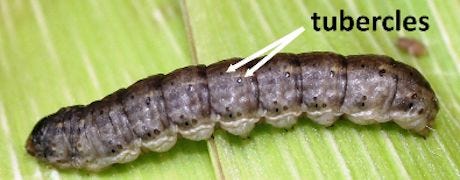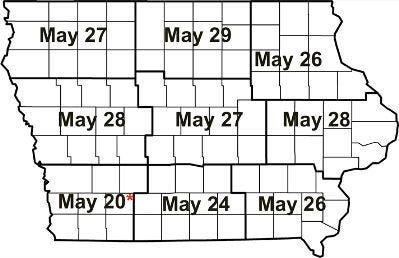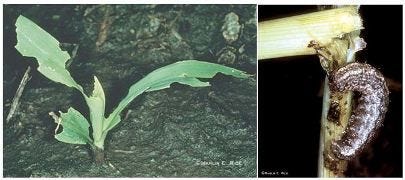May 20, 2013

It's time to start scouting your cornfields for signs of black cutworm. Iowa State University Extension entomologists have issued a scouting advisory for this insect pest. Black cutworm can clip off young seedlings and reduce corn stands—and if the cutworm population is large enough, that can happen quicker than you realize. "Keep an eye on your fields for the presence of this insect and be ready to apply an insecticide as a rescue treatment if necessary," advises Erin Hodgson, Iowa State University Extension entomologist.

SOME FIELDS ARE HIGHER RISK: Fields that are poorly drained and low lying, those next to areas of natural vegetation, and those that are weedy or have reduced tillage run a higher risk of black cutworm damage. Black cutworm may be more troublesome in fields where corn is planted late, as plants are smaller and more vulnerable to damage. Also, if a field has a high number of cutworm larvae, they may cause problems despite the use of Bt corn hybrids.
When do you need to start looking for cutworm larvae in your area? The projected dates when you can expect cutting to begin vary by region in Iowa. Cutting of emerging and young corn plants is expected to start May 20 in southwest Iowa, May 24 in south central Iowa and May 26 in southeast Iowa. East central and west central Iowa's projected start date for cutting is May 28, while central Iowa is May 27. Northwest Iowa is May 27, north central Iowa is May 29 and northeast Iowa is May 26.
These scouting advisory dates have been set by ISU Extension based on peak moth flights that are detected from a statewide black cutworm moth monitoring program. Each year, black cutworm moths fly into Iowa and other Corn Belt states from the southern U.S. and lay eggs in fields. The eggs hatch and the black cutworm larvae that are produced chew on the newly emerging and young corn seedlings.
Map shows predicted dates for cutting to start in various locations around Iowa

Estimated black cutworm cutting dates for each Iowa climate division based on peak flights of moths occurring in 2013. *The first peak flight in this district took place about three weeks before other parts of Iowa, and several other peak flights occurred here throughout April.
"We asked our black cutworm moth monitoring program participants to start watching their traps for these moths at the beginning of April," explains Adam Sisson, coordinator of ISU's Integrated Pest Management program. "The first moth trap catch was recorded in Ringgold County in southern Iowa on April 3 this year. Our predictions of cutting dates--the date when black cutworm larvae are likely to start damaging corn--are based on peak moth flights that took place beginning April 8 in the southwest corner of the state. Estimated peak flights for other locations in Iowa occurred toward the end of April and beginning of May."~~~PAGE_BREAK_HERE~~~
The map accompanying this article shows the predicted cutting dates for the nine Iowa crop reporting districts. Predictions are based on actual and historical degree-day data accumulated from the dates of peak flights, explains Laura Jesse, an entomologist at the ISU Plant and Insect Diagnostic Clinic at Ames. She helps Sisson and Hodgson with the black cutworm monitoring program in Iowa.
How to scout for black cutworm—what you need to look for in corn fields

Black cutworm larval damage usually starts above the soil surface. Leaf feeding (left) can occur. As larvae mature, they can cut plants (right). Photos copyright Marlin Rice.
Black cutworms are light grey to black with granular-appearing skin and four pairs of fleshy prolegs on the hind end. They can be confused with another insect that may be found in fields during spring--the dingy cutworm. However, there are some characteristics that can help to set species apart, which are outlined further in this article on cutworm identification.
Dingy cutworm, for example, doesn't do nearly as much damage to corn as black cutworm can do. Dingy cutworm tends to chew on the leaves, which can regrow and the plant can recover. Dingy cutworms generally don't do economic damage and it generally isn't worth spraying an insecticide to try to kill them. But black cutworms can do more leaf damage and can clip off corn plants entirely and reduce stands.
Some fields may be at higher risk for black cutworm damage than other fields
Certain fields may be at a higher risk for black cutworm damage than other fields, says Hodgson. These fields include those that are poorly drained and low lying, those next to areas of natural vegetation and those that are weedy or have reduced tillage. Black cutworm may be more troublesome in fields in which corn is planted late, as plants are smaller and more vulnerable to damage. Also, if high numbers of black cutworm larvae exist in a cornfield, they may cause problems despite the use of Bt corn hybrids.~~~PAGE_BREAK_HERE~~~
Scouts are encouraged to start looking several days before the estimated cutting dates as local development of black cutworm may be sped up (or slowed down) by localized weather. Larvae from later or yet to occur peak flights can continue to damage corn, so it is important to continue scouting, especially with the later planted corn in 2013.
Fields should be scouted for black cutworm once a week until corn reaches V5 growth stage
Fields should be scouted for larvae weekly until the corn reaches V5 growth stage, says Hodgson. You scout for black cutworm larvae by examining 50 corn plants in five areas in each field. Look for plants with wilting, leaf discoloration and damage, or those that are missing or are cut (See figure 3). Note areas with suspected damage (by putting a flag in that area of the field) and return to those areas later to assess further damage. Larvae can be found by carefully digging in the soil around a damaged corn plant.
There is evidence to suggest that black cutworm eggs are able to survive for at least one night of sub-freezing temperatures. So it may be that eggs laid before the frost hit will still produce cutting larvae. "However, scouting a field is the only way to tell if an economic infestation is occurring in an emerged crop," notes Hodgson.
What thresholds should you use to help decide whether or not it will pay to treat a black cutworm infestation with a rescue insecticide?
With corn price and input cost fluctuations, a dynamic threshold may be useful to help you decide whether or not it will pay to spray an insecticide on a black cutworm infestation. An Excel spreadsheet with the calculations built in can be downloaded here and can be used to help farmers with management decisions regarding black cutworm.~~~PAGE_BREAK_HERE~~~
What about mixing an insecticide with a herbicide and using that as a "preventive treatment" for black cutworm? Preventive black cutworm insecticide treatments applied as a tank-mix with herbicides are of questionable worth, says Hodgson. "Black cutworm is a sporadic pest. Therefore, every field should be scouted to determine the presence of the insect prior to spraying insecticides."
You need to understand the biology and life cycle of the black cutworm
Adult moths fly into Iowa each spring to lay eggs which hatch, producing the black cutworm larvae that chew on emerging corn and young corn plants. The moths migrate on the wind blowing into Iowa from southern states near the start of spring; the moths then mate and lay eggs. Around 1,300 eggs are laid by a single mated adult female. Eggs are laid in crop stubble, in low spots in the field and in weedy areas of fields. Younger larvae injure corn plants by feeding on leaf tissue and older larvae can actually cutoff the corn seedlings.
If you see damage from black cutworm larvae while scouting, let ISU know
In 2013, black cutworm moth monitoring traps have been established in 43 counties in Iowa, with several counties having multiple traps. The number of moths trapped in Iowa so far can be viewed by visiting this link, selecting "View all maps" and clicking on "Iowa Black Cutworm Monitoring 2013." Hodgson explains, "You need to consider that adult moth trap captures do not necessarily mean there will be economically significant black cutworm infestations in a particular location. That's why field scouting is essential to determine if an economically damaging infestation exists."
If you see any damage from black cutworm larvae while scouting, please let the ISU team know by sending a message to [email protected]. "This information could help us to refine our prediction efforts in coming years," she says.
You May Also Like




